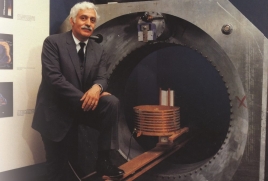Raymond Damadian
Friday, March 14, 2025
Raymond Vahan Damadian (born March 16, 1936) is an American physician of Armenian descent, a medical practitioner, and one of the first people to notice differential NMR relaxation between normal and pathological tissue.
Damadian's research into sodium and potassium in living cells led him to his first experiments with nuclear magnetic resonance (NMR) which caused him to first propose the NMR-relaxation body scanner in 1969. Damadian observed that tumors and normal tissue can be distinguished in vivo by nuclear magnetic resonance (NMR) because of their prolonged relaxation times, both T1 (spin-lattice relaxation) or T2 (spin-spin relaxation). Damadian was the first to perform a full body scan of a human being in 1977 to diagnose cancer. Damadian was among many individuals and research groups working to develop NMR-based methods to generate images of the human body, a method now known as magnetic resonance imaging (MRI).
Damadian has received several prizes. In 2001, the Lemelson-MIT Prize Program bestowed its $100,000 Lifetime Achievement Award on Damadian as "the man who invented the MRI scanner." He went on to collaborate with Wilson Greatbach, one early developer of the implantable pacemaker, to develop an MRI-compatible pacemaker. The Franklin Institute in Philadelphia gave its recognition of Damadian's work on MRI with the Bower Award in Business Leadership. He was also named Knights of Vartan 2003 "Man of the Year". He received a National Medal of Technology in 1988 and was inducted in the National Inventors Hall of Fame in 1989.
Damadian was born in New York, to an Armenian-French family, Vahan and Odette (née Yazedjian). He earned his bachelor's degree in mathematics from the University of Wisconsin–Madison in 1956, and an M.D. degree from the Albert Einstein College of Medicine in New York City in 1960. He studied the violin at Juilliard for 8 years, and played in Junior Davis Cup tennis competitions.
He met his future wife, Donna Terry, while he had a job as a tennis coach. She invited him to the 1957 Billy Graham crusade at Madison Square Garden, and he responded to the altar call. Raymond and Donna married a year after he finished medical school, and they had three children. Raymond says that he first became interested in detecting cancer when, as a boy of 10, he saw his maternal grandmother, with whom he was very close, die painfully of breast cancer.





